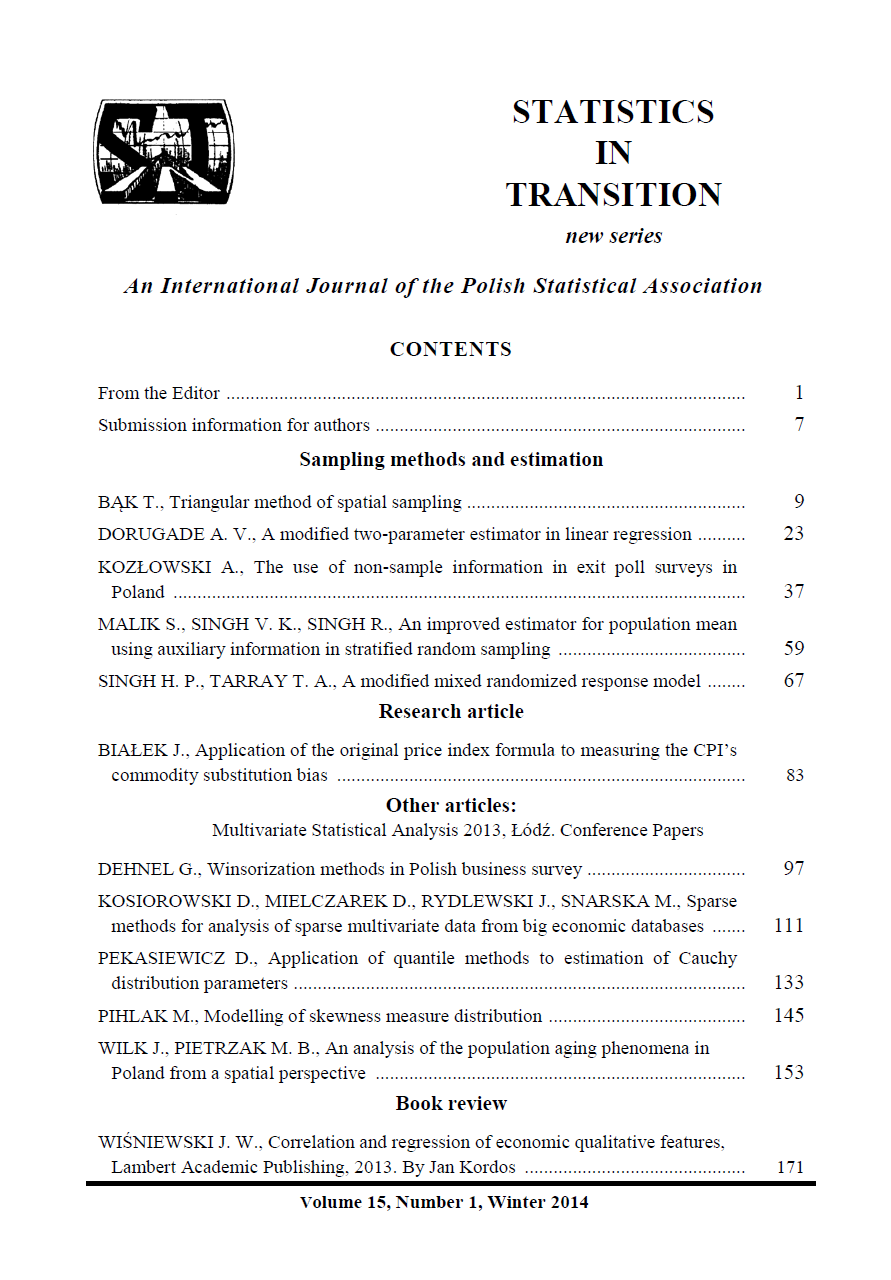ARTICLE
ABSTRACT
Socio-economic investigations often relate to certain personal features that people wish to hide from others in comprehensive inquiries, detailed questionnaires include numerous items. Data on most of them are frequently easy to procure merely by asking, but a few others can be on sensitive issues for which people are not inclined to state honest responses. For example, most people prefer to conceal the truth regarding their savings, the extent of their accumulated wealth, their history of intentional tax evasion and other illegal and or unethical practices leading to earnings from clandestine sources, crimes, trade in contraband goods, susceptibility to intoxication, expenditures on addictions of various forms, homosexuality, and similar issues which are customarily disapproved of by society. Open or direct queries often fail to yield reliable data on such confidential aspects of human life. Warner (1965) developed an alternative survey technique that is known as randomized response (RR) technique. Greenberg et al. (1971) presented a revised version of Warner's (1965) technique for qualitative variables. Later various modifications were given by several researchers [see Chaudhuri (2011)]. Kim and Warde (2005) and Nazuk and Shabir (2010) presented mixed randomized response models using simple random sampling with replacement sampling scheme which improves the privacy of respondents. In this paper we have suggested a modified mixed randomized response model to estimate the proportion of a qualitative sensitive variable. Properties of the proposed randomized response model have been studied along with recommendations. It has been shown that the suggested randomized response model is always better than Kim and Warde’s (2005) model while it is better than Nazuk and Shabbir’s (2010) model under some realistic conditions. Numerical illustrations and graphs are also given in support of the present study.
KEYWORDS
randomized response technique, simple random sampling, dichotomous population, estimation of proportion, privacy of respondents, sensitive characteristics.
REFERENCES
AMITAVA, S., (2005). Kim and Warde’s mixed randomized response technique for complex surveys. Jour Mod. Appl. Statist. Meth. , 4(2), 538–544.
CHAUDHURI, A., MUKERJEE, R., (1988): Randomized Response: Theory and Techniques. Marcel-Dekker, New York, USA.
CHAUDHURI, A., (2011). Randomized response and indirect questioning techniques in surveys. CRC Press, Taylor and Frances group, USA.
CHAUDHURI, A., (2004). Christofides’ randomized response technique in complex sample surveys. Metrika, 60(3), 23–228.
CHAUDHURI, A., (2002). Estimating sensitive proportions from randomized responses in unequal probability sampling. Cal. Statist. Assoc. Bull., 52, 315–322.
COCHRAN, W. G., (1977). Sampling Technique, 3rd Edition. New York: John Wiley and Sons, USA.
FOX, J. A., TRACY, P. E., (1986). Randomized Response: A method of Sensitive Surveys. Newbury Park, CA: SEGE Publications.
GREENBERG, B., ABUL-ELA, A., SIMMONS, W. R., HORVITZ, D. G.,(1969). The unreleased question randomized response: Theoretical framework. Jour. Amer. Statist. Assoc., 64, 529–539.
HORVITZ, D. G., SHAH, B. V., SIMMONS, W. R., (1967). The unrelated question randomized response model. Proc. Soc. Statist. Sec. Amer. Statistical Assoc. 65–72.
HUSSAIN, Z., SHABBIR, J., (2007). Improvement of Kim and Warde’s mixed randomized response technique for complex surveys. InterStat, July # 003.
KIM, J. M., TEBBS, J. M., AN, S. W., (2006). Extensions of Mangat’s randomized response model. Jour. Statist. Plan. Inference, 136, 1554–1567.
KIM, J. M., WARDE, W. D., (2005). A mixed randomized response model. Jour. Statist. Plan. Inference, 133, 211–221.
LANKE, J., (1976). On the degree of protection in randomized interview Internet. Statist. Rev. 44, 80–83.
MANGAT, N. S., SINGH, R., (1990). An alternative randomized procedure. Biometrika, 77, 439–442.
MANGAT, N. S., SINGH, R., SINGH, S., (1997). Violation of respondent’s privacy in Moors model – its rectification through a random group strategy response model. Comm. Statist. Theo. Meth., (3), 243–255.
MOORS, J. A., (1971). Optimization of the unrelated question randomized response model. Jour. Amer. Statist. Assoc., 66, 627–629.
NAZUK, A., SHABBIR, J., (2010). A new mixed randomized response model. Inter. Jour Buss. Soc. Sci. 1, 186–190.
RYU, J. B., HONG, K. H., LEE, G. S., (1993). Randomized response model, Freedom Academy, Seoul, Korea.
SINGH, H. P., TARRAY, T. A., (2012). A Stratified Unknown repeated trials in randomized response sampling. Comm. Korean Statist. Soc., 19, (6),751–759.
SINGH, H. P., TARRAY, T. A., (2013a). An alternative to Kim and Warde’s mixed randomized response model. Statist. Oper. Res. Trans., 37 (2), 189–210.
SINGH, H. P., TARRAY, T. A., (2013b). An alternative to stratified Kim and Warde’s randomized response model using optimal (Neyman) allocation,Model Assist. Statist. Appl., 9, 37–62.
SINGH, H. P., TARRAY, T. A., (2013c). An improved mixed randomized response model. Model Assist. Statist. Appl., 9, 73–87.
SINGH, H. P., TARRAY, T. A., (2013d). An alternative to Kim and Warde’s mixed randomized response technique. Accepted in Statistica.
SINGH, R., MANGAT, N. S., (1996). Elements of Survey Sampling, Kluwer Academic Publishers, Dordrecht, The Netherlands.
SINGH, S., SINGH, R., MANGAT, N. S., TRACY, D. S., (1995). An improved two-stage randomized response strategy. Statistical Papers, 36, 265–271.
SINGH, S., (2003). Advanced sampling theory with applications. Kluwer Academic Publishers, Dordrecht.
SING, S., SINGH, R., MANGAT, N. S., (2000). Some alternative strategies to Moor’s model in randomized response model. Jour. Statist. Plan. Inference,83, 243–255.
TRACY, D. S., MANGAT, N. S., (1996). Some developments in randomized response sampling during the last decade – A follow up of review by Chaudhuri and Mukherjee. Jour. Applied. Statist. Sci., 4 (2/3), 147–158.
WARNER, S. L., (1965). Randomized response: A survey technique for eliminating evasive answer bias. Jour. Amer. Statist. Assoc., 60, 63–69
